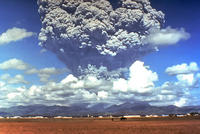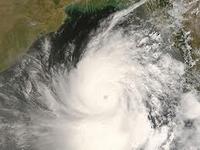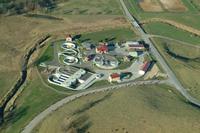-
Electric plants challenged by high temperatures, drought
The hottest July on record since 1895, along with the most wide-spread drought in the country since 1956, have nuclear plants struggling with finding enough water — cool water — to keep key parts of the plants cool; if the water gets too warm, operators have to dial back production — for reactor safety, and also to regulate the temperature of discharge water, which affects aquatic life
-
-
No-till could help stabilize crop yields despite climate change
Reducing tillage for some Central Great Plains crops could help conserve water and reduce losses caused by climate change, according to studies at the U.S. Department of Agriculture
-
-
Home, office WiFi could be used by emergency responders
Wireless routers for homes and offices could be knitted together to provide a communications system for emergency responders if the mobile phone network fails
-
-
Drone use spreads to more areas and missions

As security challenges in the United State and around the globe change, many countries have one thing in common: unmanned drones will be a significant part of the future of security; advancements in technology are driving the use of UAVs into newareas
-
-
World could be in for higher food prices
This has been one of the driest summers in American history, but the weather is not only affecting the United States; weak monsoons in India and other weather issues across the globe are affecting crops and could lead to higher food prices in 2013
-
-
Geoengineering clouds to slow global warming

Researchers are taking a second look at the possibility of using futuristic ships to shoot salt water high into the sky over the oceans, creating clouds that reflect sunlight and thus counter global warming; The theory behind idea, called “marine cloud brightening,” is that adding particles, in this case sea salt, to the sky over the ocean would form large, long-living clouds
-
-
Greenland melting breaks record four weeks early – with two weeks more to go
Melting over the Greenland ice sheet shattered the seasonal record on 8 August — a full four weeks before the close of the melting season; with more melting yet to come in August, this year’s overall melting will fall way above the old records; researchers devise a “cumulative melting index,” which measures the type of melting which adds to the runoff of melt-water that makes sea levels rise
-
-
New earthquake assessment finds increased risk for Washington Dams
Central Washington state has always been considered low risk for earthquakes back when big hydropower dams went up on the Columbia River many decades ago; a recently completed seismic hazard assessment, however, shows that there is a much greater earthquake potential for the area than previously thought; now, dam owners have to figure out whether their dams can hold up to an earthquake; if retrofits are needed, they could cost hundreds of millions of dollars
-
-
New system could predict solar flares, give advance warning to help protect power grids

Researchers may have discovered a new method to predict solar flares more than a day before they occur, providing advance warning to help protect satellites, power grids, and astronauts from potentially dangerous radiation
-
-
Close to 1,000 earthquakes shook Arizona in 3-year period: study
Historically, most of Arizona has experienced low levels of recorded seismicity, with infrequent moderate and large earthquakes in the state; comprehensive analyses of seismicity within Arizona have not been previously possible due to a lack of seismic stations in most regions, contributing to the perception that widespread earthquakes in Arizona are rare; a new study debunks this myth
-
-
Health consequences of the Fukushima disaster
The results of two studies in the 15 August issue of JAMA report on the psychological status of workers at the Fukushima nuclear power plants in Japan several months after the earthquake and tsunami in March 2011, and the amount of internal radiation exposure among residents of a city north of the power plant that experienced a meltdown
-
-
Hurricanes which pass over fresh water can be stronger

About 60 percent of the world’s population resides in areas that are prone to hurricanes or cyclones; researchers find that if a hurricane’s path carries it over large areas of fresh water, it will potentially intensify 50 percent faster than those that do not pass over such regions, meaning it has greater potential to become a stronger storm and be more devastating
-
-
Earthquake risks in Europe

How strong can earthquakes in Germany be? Where in Europe are the earthquake activities concentrated? These questions are the basis for risk assessments and become relevant when it comes to the safety of buildings or the generation of tsunami; a new Earthquake Catalogue for Europe and the Mediterranean, which offers details of 45,000 earthquakes during the last millennium, suggests answers to these questions
-
-
Climatic impacts of megapolitan expansion
Arizona’s Sun Corridor is the most rapidly-growing megapolitan area in the United States. Nestled in a semi-arid environment, it is composed of four metropolitan areas: Phoenix, Tucson, Prescott, and Nogales. With a population projection expected to exceed 9 million people by 2040; a first study of its kind, attempting to quantify the impact of rapidly expanding megapolitan areas on regional climate, showed that local maximum summertime warming resulting from projected expansion of the urban Sun Corridor could approach 4 degrees Celsius
-
-
Wastewater key to addressing growing global water shortage

Parched cities and regions across the globe are using sewage effluent and other wastewater in creative ways to augment drinking water, but four billion people still do not have adequate supplies, and that number will rise in coming decades
-
More headlines
The long view
The Surprising Reasons Floods and Other Disasters Are Deadlier at Night
It’s not just that it’s dark and people are asleep. Urban sprawl, confirmation bias, and other factors can play a role.
Why Flash Flood Warnings Will Continue to Go Unheeded
Experts say local education and community support are key to conveying risk.
